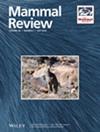Conservation Blind Spots: Scenarios for Assessing the Exposure Risk of Brazilian Mammals to Pesticides
IF 4.4
2区 生物学
Q1 ECOLOGY
引用次数: 0
Abstract
- Brazil is a large agricultural producer and a megadiverse country. In this context, the use of pesticides poses risks to non-target species, including wild mammals.
- Environmental Risk Assessment (ERA) for pesticides has been adopted by the European Food Safety Authority (EFSA) and the United States Environmental Protection Agency (EPA). Brazil has yet to present a pesticide risk assessment for vertebrates.
- To design an ERA for Brazilian mammals, data is needed on the occurrence and distribution of species within and outside crops and agroecosystem types, their biological characteristics and life history traits.
- We analyse a comprehensive dataset of mammal occurrences in Brazilian agroecosystems. We identify the main crops studied, review if pesticides were listed as threats for mammals endangered of extinction and discuss mammal traits that lead to pesticide exposure across agroecosystems.
- We show that 54% of terrestrial mammals in Brazil occur in agroecosystems (319/716), with 64.3% (205/319) of these found in crop. Most studies registered mammals in large-scale monocultures, such as annual croplands, tree plantations and pasture grazing. Small farming emerges as an important knowledge gap. We found 25 species threatened with extinction (Critically Endangered, Endangered, and Vulnerable) occurring in crop in Brazilian agroecosystems.
- Concerning ERA for Brazilian agricultural scenarios, in the screening tier process, it is suggested to use an indicator model species (IMS) with the following traits: terrestrial, crepuscular, and large body mass for pasture-grazing, tree plantations and annual croplands. Conversely, in agroforestry and perennial crop agroecosystems, we recommend considering at least one IMS with arboreal habits and a frugivorous and/or nectarivorous diet. Furthermore, in Tier 1, we recommend that a generic model species (GMS) emconpassing carnivorous and herbivorous mammals should be considered in pasture-grazing systems, tree plantations and annual cropland. In agroforests and perennial croplands, GMS that represent the diet of frugivorous and nectarivorous mammals should be prioritised.


保护盲点:评估巴西哺乳动物农药暴露风险的情景
巴西是一个农业大国,也是一个生物多样性巨大的国家。在这种情况下,农药的使用对包括野生哺乳动物在内的非目标物种构成风险。农药环境风险评估(ERA)已被欧洲食品安全局(EFSA)和美国环境保护局(EPA)采用。巴西尚未提交一份针对脊椎动物的农药风险评估。为设计巴西哺乳动物种群,需要收集作物内外物种的发生和分布、农业生态系统类型、生物学特征和生活史特征等数据。我们分析了巴西农业生态系统中哺乳动物发生的综合数据集。我们确定了研究的主要作物,回顾了农药是否被列为濒临灭绝的哺乳动物的威胁,并讨论了导致农药暴露在整个农业生态系统中的哺乳动物特征。研究表明,巴西54%的陆生哺乳动物生活在农业生态系统中(319/716),其中64.3%(205/319)生活在作物生态系统中。大多数研究记录了大型单一栽培的哺乳动物,如一年生农田、人工林和牧场放牧。小规模农业成为一个重要的知识缺口。在巴西的农业生态系统中,我们发现了25种濒临灭绝的物种(极度濒危、濒危和脆弱)。对于巴西农业情景的ERA,在筛选层序过程中,建议采用陆生、黄昏、大体质量的指标模型种(IMS),用于放牧、人工林和一年生农田。相反,在农林业和多年生作物农业生态系统中,我们建议考虑至少一种IMS具有树栖习性和食果和/或食蜜的饮食。此外,在第1层,我们建议在放牧系统、人工林和一年生农田中考虑一种包括肉食性和食草性哺乳动物的通用模式物种(GMS)。在农林业和多年生农田中,应优先考虑代表食性和食性哺乳动物饮食的GMS。
本文章由计算机程序翻译,如有差异,请以英文原文为准。
求助全文
约1分钟内获得全文
求助全文
来源期刊

Mammal Review
生物-动物学
CiteScore
12.20
自引率
4.10%
发文量
29
审稿时长
>12 weeks
期刊介绍:
Mammal Review is the official scientific periodical of the Mammal Society, and covers all aspects of mammalian biology and ecology, including behavioural ecology, biogeography, conservation, ecology, ethology, evolution, genetics, human ecology, management, morphology, and taxonomy. We publish Reviews drawing together information from various sources in the public domain for a new synthesis or analysis of mammalian biology; Predictive Reviews using quantitative models to provide insights into mammalian biology; Perspectives presenting original views on any aspect of mammalian biology; Comments in response to papers published in Mammal Review; and Short Communications describing new findings or methods in mammalian biology.
 求助内容:
求助内容: 应助结果提醒方式:
应助结果提醒方式:


